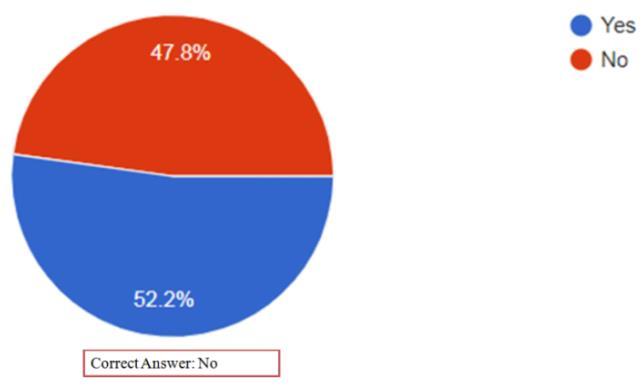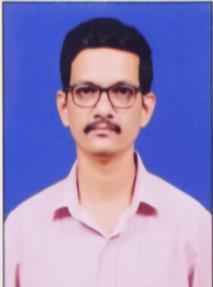
International Research Journal of Engineering and Technology (IRJET) e-ISSN: 2395-0056
Volume: 11 Issue: 10 | Oct. 2024 www.irjet.net p-ISSN: 2395-0072


International Research Journal of Engineering and Technology (IRJET) e-ISSN: 2395-0056
Volume: 11 Issue: 10 | Oct. 2024 www.irjet.net p-ISSN: 2395-0072
Dr. Dada S. Patil
Associate Professor, Department of Civil Engineering, AIKTC, SoET, Panvel, Navi Mumbai, India
Abstract - The title might puzzle the readers. The author positively hopes that the work carried out and the content presented in this paper with referencetoaneffectiveteachinglearning process, in generalandteaching-learningmechanism in engineering education, in particular would probably convince the readers about the appropriatenessandrelevance of this unusual sounding title. The so called smart engineering students of Generation Z are habituated to shortcut and mechanical way of learning rather than in-depth and conceptual learning; so, they tend to pursue the teacher for a quick way of teaching. Hence, the attainment of various learning levels, as depicted in Bloom’s taxonomy, in a true sense, remains an ambiguous issue. The author shared his short video with the second year civil engineering students to carry out an interesting exercise through Google form survey. The video contained a demonstration of calculation of two support reactions of a simply supported beam, from first year engineering mechanics course. Intentionally, theproblemwas demonstrated in a highly mechanical way through the video, without explaining the concepts at depth. A Google form containing 8 questions was circulated among the students. In all, 46 students responded. The first question was exactly similar to the problem demonstrated in the video. It was correctly answeredby30students,therebymakingthepassing rate as 65.2%. Questions 2 to 8 were related to the first question; however, critical thinking and conceptual teaching was needed to answer those. Most of the students performed poorly while attempting those questions. This clearly underlined a dire need of imparting strong fundamentals to the learners by an engineering teacher. Along with discussing the significance of various modern tools and techniquesforan efficient teaching-learning mechanism, this paper mainly stresses upon the need of conceptual teaching.
Key Words: Bloom’s taxonomy, teaching-learning, conceptual teaching, modern tools and techniques of teaching, e-learning, Google form survey, etc.
1. INTRODUCTION
Engineeringisallaboutapplyingscienceandtechnologyto design, create and upkeep the structures, machineries, variousadvanceddevices,etc.[1].Itfacilitatesengineering graduatestohaveasuccessfulprofessionalcareer,takepart in lifelong learning and play an important role for the societaldevelopment.Atgraduatelevel,itisexpectedthat thelearnerswillbeself-motivatedanddisciplined;theywill makeuseofalreadyacquiredcognitiveskillstounderstand
theconceptstaughtbytheteachers.However,engineering teacherhasstillacrucialroletoperforminordertocreate aneffectiveframeworkwhichmotivatesstudentstograsp theconceptsmostefficiently.Clark[2]gaveanequationto representthemainingredientsinhighereducationteaching, which bring about the improvement of performance of students.Belowistheequation[2,3]:
[Relationships + Variety + Synergy] = Environment for success
The effective learning by students and their academic achievementsaregovernedbytheinstructionalqualitiesofa teacher[4].Theprocessofteachingiscomplicatedandgreat practicetakestime,excellentteachingmaterial,passionfor theprofessionandtailoredfeedbackmeantforthecontinual improvement and growth of a teacher [5]. Excellence in teaching does not happen by chance. It’s not a miracle. Owing to the enormous stress on enhancing higher educationquality,effectiveteachingisbecomingimperative daybyday.

Fig.- 1: RequirementsofGoodTeaching[6]
Parametersthataffectthegoodteachingarelearner,teacher, objectivesandcontent[7].Theusefulparameterstoattain excellent teaching practices are organization of lesson, clarityoflesson,positiveclassroomatmosphereandinterest inlearning[8].Somegoodteachersmaybeborn,butmostof themaremade[9].Goodteachinghasamixtureofdifferent attributes like thorough knowledge about content, pedagogicalskills,capabilitytoinculcatesameconceptina number of ways, motivating the students, strong commitment towards students and parents, capability to

International Research Journal of Engineering and Technology (IRJET) e-ISSN: 2395-0056
Volume: 11 Issue: 10 | Oct. 2024 www.irjet.net p-ISSN: 2395-0072
manage and assess the students from the diverse background.
Mostoftheteachersinculcatingtheengineeringcoursesfind shortageoftimetocoverthevoluminoussyllabusinshort semester duration. Moreover, to cater to the shortcut learningstyleofsocalled“Gen Z”students,theyresort to “HOW”typeofteachingratherthan“WHY”typeofteaching. Theydon’texplain“why”acertainstepistobecarriedout and various approaches for the same; rather, they try to convey“how”todoitmechanicallytoobtaintheanswer.
Thisdomaincomprisesoflearningskillsinconnectionwith theprocessofthinking.Learningmechanisminthisdomain consists of a hierarchy of skills involving information processing, building up the understanding, knowledge application,problemsolvingandcarryingouttheresearch. There exist six tiers of cognitive complexity: knowledge, comprehension, application, analysis, synthesis and evaluation.

The focus of Bloom’s taxonomy was mainly on the attainmentsofvariouslearninglevels.Itdidnotmentionthe processskills.Italsofailedtocatersignificantlytoaddress thewayinwhichastudentjumpsfromlowerleveltohigher levels. This domain consists of skill clusters that help to organizeacomplete,preciseandcomplementarylistingof learningskillswhicharecrucialforeachprocess.Thereare variousaddedfeaturesinthemodifiedversionofBloom’s taxonomy [10]. Presumably more complicated mental operationisneededforattainingthehigherlearninglevels.If studentslackcapabilityofmakinguseoflowerlevels,they cannotattainthehigherlevels.Therefore,it’snotnecessary that the higher levels are greatly desired than the lower levels.
Various modern teaching techniques which have already proven their worth in enhancing the student’s learning processareflippedclassroom,tactilelearning,VAKlearning, project-based learning, problem-based learning, cooperative-learning, collaborative-learning, game-based learning, inquiry-based learning, thinking-based learning, competency-basedlearning,independent-learning,etc.Off thelate,thereismuchtalkaboutusefulnessofMassiveOpen Online Courses (MOOCs). They create interactive user forumswhichfacilitateinbuildingacommunitycomprising of teachers, learners and teaching assistants by providing coursematerialvideos,hand-outs,problemsets,etc.There are many digital tools and apps for the teachers. Quizizz, Teach Easy, Jamboard, Mentimeter are the few to name. DuringandafterCovidpandemic,theuseofdigitalmodeof teaching-learninglikeGoogleclassroom, postingYouTube videos,GoogleMeet,Zoom,MicrosoftTeam,GoToMeeting, etc. have been on the rise. Some students find traditional teachingstressfulandmoderntoolsandmethodsjoyfulfor theirlearning.Modernlearningmodemotivatesthelearners to collaborate with each other. Online learning model facilitatesthestudentswithonlineplatformfordiscussions. Throughe-learning,studentshaveanadvantageoflearning with their own pace. However, a traditional teaching provides face-to-face working for the students. It is more direct. Interpersonal skills are developed among the students.Blendedlearningwhichcombinestraditionaland moderntechniquesofteachingisalsoabetteroptiontosave ontimeandtoimprovelearners’academicperformance.
Theutilizationofmodernteachingtoolsandmethodsdoes notnecessarilyensurethattheconceptsaretaughtcorrectly andatrealdepth.Thesearecompletelytwodifferentthings. Many engineering courses, highly analytical in nature, demandin-depthandconceptualteaching.Itisusuallysaid that “state-of-the-art infrastructure and aesthetically pleasing buildings alone don’t make the institute; but, the motivatedhumanresourcesandpassionatestudentsmake theone”.Onthesimilarline,onlymakinguseofsmartmodes of inculcating the students without bothering about the importanceofinstillingthefundamentalconceptsinthemis likeacceleratingacarwithoutchangingthegear.Itwillonly makeanoisewithoutgainingthespeed.Traditionalwayof teachinghasitsownpeculiarityandsignificance.Hence,it cannotbefullyreplacedbythemodernandsmartmethods. Itcanonlybesubstantiatedthroughnovelapproachesusing technologicaladvancements.

International Research Journal of Engineering and Technology (IRJET) e-ISSN: 2395-0056
Volume: 11 Issue: 10 | Oct. 2024 www.irjet.net p-ISSN: 2395-0072

Fig. – 3: ASimplySupportedBeam
Afterstudentswatchedauthor’sshortvideo,theyweregiven asimilarproblem(figure3),throughtheGoogleformand8 questions were asked. Responses of 46 students are indicatedbelow.
Q.(1)CalculatethereactionsathingesupportAandroller supportBandchoosethecorrectoption.

Fig.- 4: CalculationofSupportReactions
The correct answer was fourth option. It was correctly answered by 30 students, thereby making passing percentageas65.2%.Itwasexpectedthateveryonewould answercorrectlybecauseitrequiredonlymechanicalwayof solvingwithoutcriticalthinkingprocessinvolved.However, students’performancewasjustsatisfactory.
Q.(2)Ifrollersupportsareprovidedatboththeendsofthe beam,thebeamwillbestable.TrueorFalse?

– 5: KnowledgeaboutBeamStability
Thecorrectanswerwas“False”.Question2requiredabitof conceptualthinking.31(i.e.67.4%)studentscouldanswerit correctly.
Q.(3)Clockwiseactionformomentsandupwarddirection forloadsandreactionswereassumedpositiveinthevideo demonstration. If anticlockwise moments and downward loadsandreactionsareassumedpositive,magnitudesand directionsofreactionsatA&Bwillremainunchanged.True orFalse?

Fig. - 6: ConceptofSignConventions
Thecorrectanswerwas“True”.Itwasansweredcorrectlyby only 26 (56.5%) students. This proved that the students’ conceptaboutsignconventionwasnotclear.Thisconceptis vitaltolearnhighersemestercourses.
Q.(4)Aftersolvinganysuchproblem,ifwegettotalupward forces(i.e.reactions) equal tototal downwardforces(i. e. loads) asa final cross check,does itdefinitelyensurethat valuesofboththereactionsarecorrect?SelectYesorNo.

Fig.-7: KnowledgeaboutCrossCheckingtheAnswers
The correct answer was “No”. Only 7 (i.e.15.2%) students couldcorrectlyanswerquestion4.Itwasrelatedtothefinal crosscheckingofthecorrectnessoftwosupportreactions. Thisisaseriousconcernowingtothetrialanderrorstyleof students’learning.

International Research Journal of Engineering and Technology (IRJET) e-ISSN: 2395-0056
Volume: 11 Issue: 10 | Oct. 2024 www.irjet.net p-ISSN: 2395-0072
Q. (5) Initially, instead of assuming both reactions to be actingupwards,ifbothareassumedactingdownwardsor anyoneactingupwardsandanyonedownwards,willthere beanychangesinvalues(magnitudeordirectionorboth)of reactionsatsupports?SelectYesorNo.

Fig. - 8: InitialAssumptionsofDirectionsofReactions
“No”wastheexpectedanswer.Studentsdidnotfarewellin question5.Thedesiredanswerwasgivenby22(i.e.47.8%) studentsonly.
Q. (6) If your answer was any of the first 3 options in question (1), neglect this 6th question. However, if your answerwas4thoption(i.e.boththereactionsaresame)then shortly write your comment: why both the reactions are same?
The expected answer was: The external effect of given uniformlydistributedloadisequivalenttoapointloadof40 kN acting at 2 m. from the end A. So, it becomes a symmetricalloadingcase.Outof46students,only6students could write approximately close answer. But, none of the answers was precise. When precise descriptive answer involving a technical concept is sought in engineering, answersreflectingagreyareacannotbeaccepted.
Q.(7)Toensurelesschancesofmakingmistake,isitbetter touseΣMA =0orΣMB =0?
The desired answer was Σ MA = 0, because Uniformly DistributedLoadisclosertoA.Outof46students,only15(i. e.32.61%)studentswrotethecorrectanswer.
Q.(8)Conceptually,athowmanypointsonthebeamACDB, ΣM=0canbewritten?
The expected answer was: At every point on the beam. However, no student answered it correctly, thereby indicatingthatthoughtheylearntequilibriumequationsto solve the problems, they were unaware of the precise underlyingconcept.Questions2to8wererelatedtothefirst question. However, unlike the first question which
demanded only mechanical approach, those questions demandedconceptualandlateralthinkingskills.
One more interesting analysis was done and it was found that,outof30studentswhoobtainedcorrectreactionvalues in first question, only 21 (i. e. 70%) students answered secondquestioncorrectly,15(i.e.50%)studentsattempted third question correctly, only 3 (i. e. 10%) students could answer fourth question correctly, 15 (i. e. 50%) students answered fifth question correctly, no one answered sixth questioncorrectly,14(46.67%)studentsattemptedseventh questioncorrectlyandnoonewassuccessfulinanswering theeighthquestioncorrectly.
As a part of maintaining the academic documents for the assigned subject, engineering teachers mention that the topiclearningoutcomesandvariouscourseoutcomeshave beensuccessfullyattainedattherequiredBloom’slearning levels through the activities like assignments, term tests, viva-voce, end semester examination, etc. However, attainmentinarealsenseisabigissue
Had the in-depth and conceptual teaching been demonstrated through the author’s video, most of the students could have probably answered all the questions correctly.
The hierarchy of skills as well as processes in cognitive domainneedtobethoroughlyunderstoodbyteachersand students so that they are able to know prerequisite knowledge for learning and also the manner in which the skillsarerequiredtobetransferredtoachieveexcellencein complexelementsofdiscipline-specificconceptinventories. For teaching or learning new concepts, development of learning skills shall never be taken for granted. Imparting conceptual knowledge to the engineering students is the only way for a complete teaching-learning mechanism. Thoughthe major objectivesof engineering education are successinexaminationandgoodplacements,theycannotbe the only driving forces. Passing the examination does not necessarily ensure that the students have acquired knowledgethroughthefundamentalandin-depthlearning. The ultimate aim of engineering teacher is to create a positive environment for students to be a better engineer possessing sound domain knowledge. If the trees are cut (aftertheirusefullifeisover!!!!!)withabluntaxe,tosave upon sharpening time, it leads to more effort with low efficiency.Onthecontrary,ifenoughtimeisgiventosharpen the axe initially, time and efforts can be saved later on. Engineering teachers facing the shortage of time are unwillingly compelled to finish-off the content in a mechanical way to get aligned with the students’ quick learningstyles.However,theycaninvestanextratimeand planmeticulouslysothattheirteachingbecomesanoptimal combinationofconceptualinputsandmechanicalapproach.

International Research Journal of Engineering and Technology (IRJET) e-ISSN: 2395-0056
Volume: 11 Issue: 10 | Oct. 2024 www.irjet.net p-ISSN: 2395-0072
Thisisaverycrucialfactorinengineeringeducationbecause successcannotbemeasuredonlyquantitativelyintermsof students’ passing percentage, placements, etc. It has to be also assessed in the light of qualitative approach such as students qualifying GATE, cracking various Government examinations, enrolling for higher studies and research programsinpremierinstitutes,etc. Conceptualteachingis likeacompletemealandusageofmoderntoolsandmethods is like a pickle. The later spices-up the former, thereby making the meal interesting. But, a meal having different quality ingredients cannot be completely replaced by a pickleoracombinationofdifferenttypesofpickles!!!
Ifengineeringstudentsaretaughtonlyfromtheexamination pointofview,theymaypassorevenscorewell.Butthatis not the sole purpose of obtaining an engineering degree. Theyneedpracticalandlateralthinkingapproachtosurvive andthriveintherealworld.
TheunorthodoxandbadshothitbyabatsmaninT20cricket matchfetchesaboundaryfortheteam,owingtothekindof field set up. It takes the batsman and team towards the successintermsofwinningthematch.Thespectatorsinthe groundandthosewatchingthetelevisiongetanephemeral joy.However,whenthesamebatsmanplays a testcricket whereinthefieldsetupisentirelydifferent;combinedwith an in-depth analysis for every ball being bowled, he gets caughtwithoutanysignificantcontributiontohisownscore andtheteamscore.Inspiteofhavingexcellentbattingskills, he miserably fails because of his habit of shortcut way of attaining the objective of winning to satisfy the team requirementandtocopeupwiththewhimsandfanciesof spectators.Insteadofexplaininghowthisanalogyisrelated totheengineeringteacher,his/herdepartment,collegeand students,theauthorleavesittotheimaginationofreadersto read between the lines and understand a vital message in disguisetobring-inthemuchneededchangesinteachinglearningprocessinengineeringeducation.
[1] Husain Z., and Kumar D. Challenges for Holistic EngineeringEducationDevelopmentinIndia.International Journal of Evaluation and Research in Education (IJERE). 2014;3(1):11–18.
[2]ClarkB.TheCooling-Out’FunctioninHigherEducation. AmericanJournalofSociology.1960;65(6):569–576.
[3]ClarkR.,andAndrewsJ.Relationships,variety&synergy: the vital ingredients for scholarship in engineering education? A case study. European Journal of Engineering Education.2014;39(6):585–600.
[4] Mohanty R. C., and Panda B. N. How to Become a CompetentTeacher.NewDelhiIndia:DiscoveryPublishing House;2003.
[5] Bill and Melinda Gates Foundation Ensuring Fair and Reliable Measures of Effective Teaching. Culminating FindingsfromtheMETProject’sThree-YearStudy.2013.
[6]Aabha C.,Bani B.,and Shyamal K.Centre.Attributes of good teaching in engineering education in Indian subcontinent.Sadhana,IndianAcademyofSciences.2018; 43(188):1-12.
[7] McKeachie W. J. Student Ratings: the Validity of Use. AmericanPsychologist.1997;52(11):1218–1225.
[8]Hativa N.,Barak R.,and SimhiE. Exemplaryuniversity teachers:Knowledgeandbeliefsregardingeffectiveteaching dimensionsandstrategies.TheJournalofHigherEducation. 2001;72(6):699–729.
[9] Raghuram N. Good Teaching as an Attitude. Secrets of GoodTeaching(VineyKirpal).2004;135–146.
[10]AndersonL.W.,andKrathwohlD.R.(eds.).Ataxonomy forlearning,teachingandassessing:ArevisionofBloom's Taxonomyof educational objectives.New York:Longman; 2001.
AUTHOR’S BIOGRAPHY

Dr Dada S. Patil works as an Associate Professor in Civil EngineeringDepartmentinAIKTC, Panvel,NaviMumbai,India.Hehas 2.5 years of industrial experience and 22 years of teaching experience at degree level His areas of interest are Structural Engineering, Advanced Concrete Technology, Geotechnical Engineering, Effective TeachingLearning Process in Engineering, etc